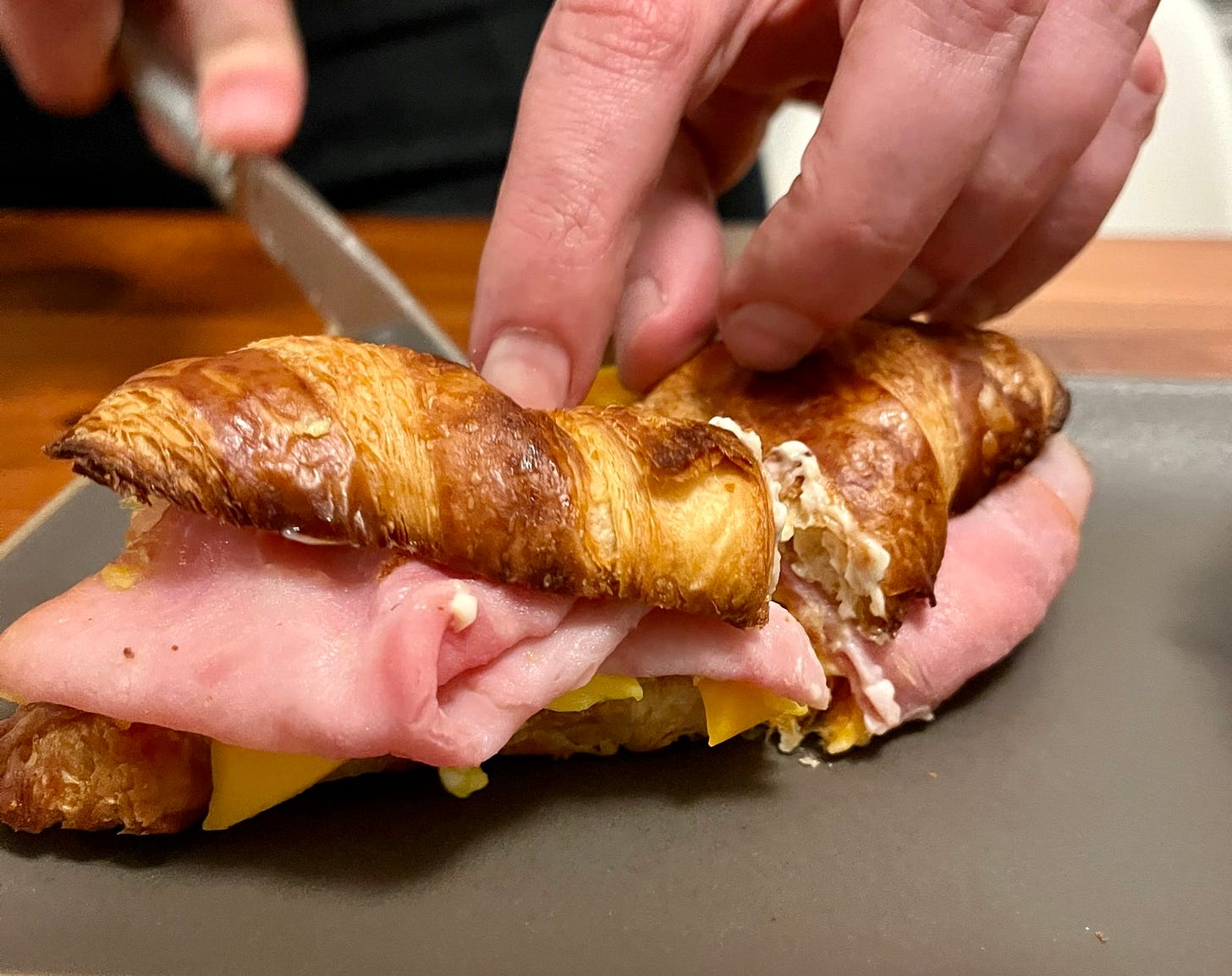Breakfast sandwiches. I eat them. I love them. But prior to the pandemic, I rarely ever made them. Sure, I’d taken a stab at them a few times pre-2020, but those were mostly sad failures. Once the world shut down, however, I became Breakfast Sandwich Curious. Surely, I could learn how to make a proper breakfast sandwich, right? Nothing too fussy or elaborate — just a basic breakfast sandwich like the kind you’d find at a local doughnut shop or deli.
Don’t get me wrong — I loooove a fancy version. Give me all the aiolis and imported cheeses. But give me that in a restaurant. If it’s a Tuesday morning and I need to start my day, I want a breakfast sando I can whip up effortlessly from pantry ingredients.
And so, as lockdown slogged on, I worked on my breakfast sandwich technique, testing different breads, meats, and egg preparations. I looked for ingredients that were delicious but also not precious — things that could last in the back of the fridge for a few weeks and be ready at a moment’s notice. You would think it’s easy to make a breakfast sandwich… and that is absolutely correct. However, it turns out that a breakfast sandwich has enough of a decision tree that things can go awry. Well, not awry — that’s so dramatic. No breakfast sandwich will ever go truly awry unless it bursts into flames — which I suppose is a possibility for some people. But, if treated thoughtlessly, your breakfast sandwich might just be… mediocre? Maybe the cheese won’t melt right or the bread will fall apart. Getting the right composition is essential. I’ve fallen into many of the traps on my breakfast sandwich journey, and here’s what I’ve learned.
The eggs
I suspect there are three major categories for breakfast sandwich eggs: fried, scrambled, or folded. In the outside world, I’m down for all of them. In my kitchen, I go for folded, which is basically an omelet that I’ve folded on top of itself into a square shape. I like the speed with which folded eggs come together. Every minute eggs are cooking is another minute toast is cooling, after all. Additionally, folded eggs hold their structure better than scrambled eggs, which tend to plop out onto the plate with every bite.
A fried egg does have the advantage of a gorgeous, runny yolk, which we love, but again, fried eggs often take longer to cook than folded eggs and require more precision (you don’t want to mess up that yolk; otherwise what’s the point??). Plus, I enjoy using two eggs on my breakfast sandwich, and I’m not sure that’s truly doable with fried eggs. I will never turn my nose up at anyone who goes the fried egg route, but I’ve ultimately found the speed, structure, and ease of folded eggs is the winning combo. Plus, it’s the most Egg McMuffin-y approach, and that has to mean something.
The cheese
I’ve done cheddar, Swiss, gruyere, and even cream cheese, to name a few, on my breakfast sandwiches, and they all work. I can’t really think of any cheese that wouldn’t be great. Feta might be a challenge, and the learning curve on goat cheese or a bleu is probably steep — but I suspect even those cheeses could succeed on the right breakfast sandwich. My choice, however, is far less gourmet: American cheese.
Processed cheese has a time and a place, and one of those times and places is on my breakfast sandwich. Put aside your snobbery and lean into American cheese’s industrially designed melting point. It will serve you well! Tastes good too!
The meats
Ham. I choose ham. Specifically honey ham. It’s already cooked, slightly sweet, and doesn’t feel like a bowling ball in your stomach. Failing that, my second choice is turkey bacon - again, subtle sweetness and not a punch to the gut. The downside is that turkey bacon takes more effort than ham; hence, it’s not my go-to.
I’m less drawn to bacon and sausage when making breakfast sandwiches at home. They both add more work to the process, and both meats have drawbacks: bacon can be very salty, and sausage feels especially heavy. This is the part where people say “but ham is salty” or “bacon is so easy to make” or “sausage is delicious.” Yes. I know this. I get it. But ham is the easiest, lasts the longest in the fridge, and has a lovely texture. STOP YELLING AT ME.
The bread
Bread is a real challenge for me. My favorite without question is a croissant, which toasts up with crisp edges and delicious, flaky layers. English muffins are a close second, but they’re often a bit too small to hold all the eggs, meat, and cheese. Many people love a bagel for a breakfast sandwich, but I find them too firm. Each bite seems to squeeze fillings out the back of the sandwich.
Croissants on the other hand are big enough to support two folded eggs and gentle enough to ensure the sandwich remains intact with every bite. They do it all. Croissants, it turns out, are nearly perfect.
The problem with croissants is that they take up an annoyingly large amount of storage space. Their bulky packaging is not as compact as, say, a sleeve of English muffins or bread-aisle bagels. Plus, a croissant feels a bit too indulgent sometimes. Surely there is another bread out there that hits the sweet spot of size, structure, flavor, and texture without incurring bouts of guilt.
Unfortunately, I haven’t found it yet. I’ve tried many things: Hawaiian rolls (too sweet and too soft), burger rolls (unremarkable), brioche (the texture is too soft-on-soft-on-soft), sandwich thins (the very WORST of the bunch), Kaiser rolls, telera rolls, regular bread, open faced sourdough, and more. Nothing has really blown me away yet. The journey will continue, but for now, my go-to remains a croissant, even if English muffins wind up being the bread I use most frequently - as seen in the top photo. You honestly can’t go wrong with either one, tbh.
Other stuff:
Avocado is a great addition in theory, but the slices can be bulky and slippery — more of a hassle than anything else. Also, you’re not going to use a whole avocado on one egg sandwich, and we all know how chaotic avocados are when it comes to storing their leftovers. I will not play these games!
I do partake in mayonnaise, controversially. This is a new thing for me. Somewhere along the way, mayo wormed its way into my grilled cheeses and breakfast sandwiches, and I haven’t turned back. The condiment offers both moisture and a vital tangy flavor that cuts through the sandwich’s richness. If you’re someone who’s skeeved out by mayonnaise, I respect your lifestyle. But to everyone else, I highly recommend embracing the mayo.
To that end, I recently purchased my first ever bottle of Kewpie mayonnaise, a Japanese brand that is beloved by many. I can confirm that it is absolutely delicious and wonderful; however, when I added Kewpie to a breakfast sandwich recently, it fell short. I couldn’t taste the tang! I was shocked. I may revisit, but for right now, I suggest sticking with a classic like Hellmann’s (or Best Foods, depending on which side of the Mississippi you’re on).
So, here we are. After months of experimentation, I’m happy to report I’ve landed on a very satisfying, very tasty, and very easy breakfast sandwich. I’ve written down the method in granular detail, which makes it look more difficult than it actually is. Mostly, it’s all about sequencing. Let’s get into it.
NBD Breakfast Sandwich
Serves 1
Ingredients
1 croissant, generic supermarket variety is not only fine, but ideal. Or English muffin
2 eggs
1 tbs milk, half-and-half, heavy cream, or whatever dairy is in your fridge, optional
Kosher Salt
2 slices American cheese
2 slices honey ham or cooked turkey bacon
2-3 tsp mayonnaise, to taste
Butter or butter alternative, optional
Olive oil
The Steps
1. Toast the bread: Slice your croissant or English muffin in half and toast to a medium / medium dark color.
• If you overdo it, don’t freak out. There’s enough going on in the sandwich to hide charring.
• Don’t go too light. You definitely want some color on your bread for not just flavor, but also to stiffen it up so it can hold the eggs better. Plus, the residual heat helps melt the cheese; so don’t be timid.
2. While the bread is toasting: remove the American cheese slices from their plastic. Also, pull out the two pieces of ham from their container. Set these all aside.
• It’s weird that I’m specifying the timing on this, but trust me, you don’t want to be fiddling with plastic or prying apart ham later on when you’re trying to focus on the eggs.
3. Crack two eggs into a small bowl and add a pinch of salt – about 1/8 to 1/4 of a teaspoon. Whatever you’re comfortable with. If you’re using dairy (I rarely do), add a small bit of it now. Beat the eggs until combined and not streaky with the whites – about a minute.
4. Add a mini glug – about 1-2 tsp – of oil to an 8” omelet pan or skillet (you want a small pan for this) over medium-high heat.
5. Once your toast is finished, remove the croissant or English muffin from the toaster and spread mayo on the top slice. Do it to taste.
• I like to add more than a thin sheen but not so much that it looks like icing. If you’re feeling fancy, optionally spread butter on the bottom slice.
• The butter isn’t make or break; so feel free to omit it if you’d rather have one less thing to worry about.
6. Place one slice of American cheese on the bottom half of the croissant to give it a head start for melting.
7. Make the eggs: Your oil should be hot by now. Pour the eggs into the skillet. Make an omelet and fold it over itself into a square. If you don’t know how to do this, here is your guide, inspired by Chef John:
With a rubber spatula, swirl the eggs all around, making firm contact with the pan and the spatula. Do figure-eights if that helps, but don’t forget to scrape along every part of the pan. This will last about 30 seconds or maybe even less.
Once the eggs start to look less like liquid and pull away from the sides like a scramble, drop the heat to low and then spread the eggs across the entire bottom of the pan. There will still be pools of beaten egg amongst the curds.
Push the runny pools towards the sides of the pan, tilting with the handle to help the liquid along. Use your spatula to gently pry away the cooked edges so the liquid can pool underneath and cook. Continue to pat wet areas down into any holes or thin sections, tilting if necessary. It’s an adorable little dance you’re doing and very easy.
Once there are no more runny areas and only soft, wet-ish surfaces, stop doting and just let the whole thing cook undisturbed for about 30 seconds.
Cut the heat and slide the spatula under one edge of the eggs. Tilt the pan away from your spatula, and then lift the edge up, over and across the eggs, like you’re closing a book. By tilting the pan, you’re giving yourself an assist from gravity. If your egg edge flopped out before getting all the way across, don’t worry, just pry the opposite edge up and over so that the two edges meet. This doesn’t have to be super precise.
In the pan you’ll have either a semicircle or a weird envelope blob. Fold the long edge over on itself, resulting in a square-ish shape that will fit perfectly on your croissant or English muffin.
8. Tilt the skillet and slide the egg-square onto the cheese-covered slice of bread. Place the second slice of American cheese on top of the egg. If you are going meatless, then congrats. You are done. Close up that sandwich! Otherwise, continue on.
9. Return the skillet to a medium heat (don’t bother wiping it clean) and toss in the two slices of ham (or turkey bacon if using). They’ll sizzle, maybe even flap because they’re dramatic, and eventually release some liquid. Cook the slices until they’ve warmed through, about a minute.
• If you really want to treat yourself, you can try to get some color on the ham, but I haven’t found it to be worth the time and effort.
• Warming the ham helps the second slice of cheese melt.
10. Pile the hot ham on top of the second slice of American cheese (rumpled and tall, not flat), close the sandwich, and bask in the glory that is your breakfast.
How do you like your breakfast sandwiches?








My teenage son turned me on to browning the cut sides of English muffins in butter rather than toasting. I like it because I still get the browned, toasty taste (plus extra butter, which is great), but the English muffin doesn’t eat as tough as when it’s toasted. I imagine the croissant has more give so it’s not as much of an issue. And now it’s 6:20 and I really want a breakfast sandwich.
Thank you for all this recipe testing! A croissant is an indulgent option but delicious but I may opt for the english muffin for the work week. It's nice to have this because in the past I've eaten the hockey puck frozen breakfast sandwiches that never heat correctly and are full of sodium. Your recipe here is so welcomed! I will make these soon! Thank you Ben for this newsletter as I am also very enthusiastic about home cooking.